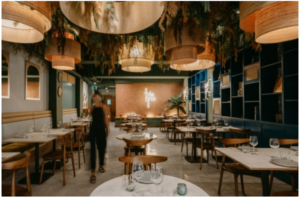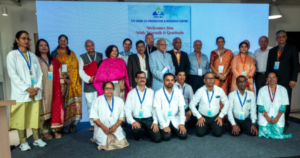By – Dr. Usha Thakkar (President, Mani Bhavan Gandhi Sangrahalaya)

Mani Bhavan, a modest two-storied building on the Laburnum Road in the locality of Gamdevi, treasures the precious memories of Mahatma Gandhi and freedom struggle in
India. It is a special museum vibrating with the visits by thousands of visitors from all over the world. It served as Gandhiji’s Bombay head-quarters whenever he was in the city between 1917 and 1934. It belonged to Shri Revashankar Jagjeevan Jhaveri who was an ardent devotee of Gandhiji and his painstaking host during that period.
Today it is an important memorial to Gandhiji, to his frequent stay here and to the activities he initiated from this place. Mani Bhavan has a story to tell as it housed Gandhiji occasionally during the times
when he grew in stature and strength, from an agitator to a world figure by successfully introducing Satyagraha (individual as well as mass) as a new and effective weapon to fight all evil
and injustice.
Mani Bhavan is one of the few important buildings hallowed by Mahatma Gandhi’s close association. It was the epicenter of India’s unique struggle for freedom especially from 1917 to 1934. Mahatma Gandhi began to direct the destiny of our people from here when in Bombay. In fact it was from here that first phase of nation-wide non-violent freedom struggle was launched. Satyagraha against the Rowlatt Act was launched from here on April 6, 1919. With a view to defy the Indian Press Act, Gandhiji began issuing from here an unregistered weekly bulletin Satyagrahi from April 7, 1919.
Gandhiji took his first lessons in carding from a person who used to pass by Mani Bhavan every day. He yielded to Kasturba’s suggestion and began taking goat’s milk here when his health was critical in January 1919.
Gandhiji started his historic fast on November 19, 1921 to restore peace in the city of Bombay after disturbance and disorderly scenes at the time of the boycott of the visit of the Prince of Wales on November 17, 1921. He broke his fast on November 22, after quiet was restored in the city. As he stated his epic journey from Sabarmati Ashram to Dandi on March 12, 1930, Bombay was agog with excitement.
The Congress Working Committee met here on June 9, 1931 and decided to send Gandhiji as the sole representative of the Congress to the Round Table Conference in London. He returned to Bombay full of frustration on December 28, 1931. Thereafter, he discussed the situation with the Working Committee of the Congress which met in Mani Bhavan and took the decision to launch civil disobedience for Swaraj at midnight on December 31, 1931. Gandhiji was arrested from his tent on the terrace of Mani Bhavan in the small hours of the morning of January 4, 1932. An adjourned meeting of the Congress Working Committee was held here on June 17 and 18, 1934. Mani Bhavan is a place where Gandhiji lived and conversed with his colleagues, and moulded the nation in the image of the cherished ideals of Truth and Non-violence.
After Gandhi’s martyrdom in 1948, it was turned into a Gandhi Museum which is national memorial to the Father of the Nation. It is a heritage building placed on the tourist map of Mumbai and is visited daily by a large number of Indian and foreign visitors. On March 3, 1959 when Jawaharlal Nehru , the first Prime Minister of India, revisited Mani Bhavan, observed “Mani Bhavan in Bombay will ever remain a precious memory to all those who visited it on many occasions when Gandhiji used to stay there. I am glad therefore, that this house is being converted into a Gandhi Memorial”.
The ground floor of the building houses the office of the Museum and the Library. At the entrance on display are important books by and on Gandhiji and Gandhi stamps issued by India and other countries. On the first floor is the auditorium where the documentary Mahatma is shown from time to time. It is also used for holding meetings, seminars, discussions and various competitions for school and college students. Around 8000 students participate in the Gandhi Jayanti competitions on topics related to Gandhiji’s life and work. On the second floor the room where Gandhiji lived and worked is preserved in its original setting. Adjoining Gandhiji’s Room is the exhibition depicting Gandhiji’s life through mini figures in about twenty-eight tableaux, prepared by Smt. Sushila Gokhale Patel. Gandhiji’s inspiring quotes and historical photographs in the museum evoke the memories of India’s non-violent struggle for independence. Prayer meetings are organized on 2nd October and 30th January; and lectures and programmes are arranged during the National Week and the October Week.
Gandhiji’s ideas and the activities of Mani Bhavan Gandhi Sangrahalaya are displayed on the website: www.gandhi-manibhavan.org The website is a rich source of information and reference for researchers, scholars, students and general public alike. Various queries from the researchers, students and tourists relating to Gandhiji and Mani Bhavan are also answered.
Mani Bhavan is open to public on all days between 9.30 a.m. to 6.00 p.m.
Mani Bhavan, once the
residence of the Father of the Nation is now source of inspiration for freedom
and peace loving men and women all over the world. The
visitors – ranging from the heads of States to the students – carry from here
the message of peace and non-violence. Mani Bhavan is an important museum that draws
our attention to Mahatma Gandhi’s ideals, glorious pages from the history of
our freedom struggle and Mumbai’s contribution to this unique struggle for
freedom.






The article on mani bhavan was really informative